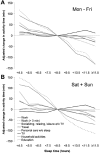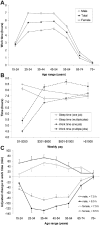American time use survey: sleep time and its relationship to waking activities
- PMID: 17910380
- PMCID: PMC1978395
- DOI: 10.1093/sleep/30.9.1085
American time use survey: sleep time and its relationship to waking activities
Abstract
Study objectives: To gain some insight into how various behavioral (lifestyle) factors influence sleep duration, by investigation of the relationship of sleep time to waking activities using the American Time Use Survey (ATUS).
Design: Cross-sectional data from ATUS, an annual telephone survey of a population sample of US citizens who are interviewed regarding how they spent their time during a 24-hour period between 04:00 on the previous day and 04:00 on the interview day.
Participants: Data were pooled from the 2003, 2004, and 2005 ATUS databases involving N=47,731 respondents older than 14 years of age.
Interventions: N/A.
Results: Adjusted multiple linear regression models showed that the largest reciprocal relationship to sleep was found for work time, followed by travel time, which included commute time. Only shorter than average sleepers (<7.5 h) spent more time socializing, relaxing, and engaging in leisure activities, while both short (<5.5 h) and long sleepers (> or =8.5 h) watched more TV than the average sleeper. The extent to which sleep time was exchanged for waking activities was also shown to depend on age and gender. Sleep time was minimal while work time was maximal in the age group 45-54 yr, and sleep time increased both with lower and higher age.
Conclusions: Work time, travel time, and time for socializing, relaxing, and leisure are the primary activities reciprocally related to sleep time among Americans. These activities may be confounding the frequently observed association between short and long sleep on one hand and morbidity and mortality on the other hand and should be controlled for in future studies.
Figures



Comment in
-
Social and demographic factors related to sleep duration.Sleep. 2007 Sep;30(9):1077-8. doi: 10.1093/sleep/30.9.1077. Sleep. 2007. PMID: 17910376 Free PMC article. No abstract available.
References
-
- Simpson NS, Punjabi NM, Dinges DF. Sleep and mortality. In: Chokroverty SM, Montagna P, editors. Handbook of clinical neurology. Elsevier; (in press)
-
- Kripke DF, Garfinkel L, Wingard DL, Klauber MR, Marler MR. Mortality associated with sleep duration and insomnia. Arch Gen Psychiatry. 2002;2:131–6. - PubMed
-
- Vioque J, Torres A, Quiles J. Time spent watching television, sleep duration and obesity in adults living in Valencia, Spain. Int J Obes Relat Metab Disord. 2000;12:1683–8. - PubMed
Publication types
MeSH terms
Grants and funding
LinkOut - more resources
Full Text Sources
Other Literature Sources
Medical

